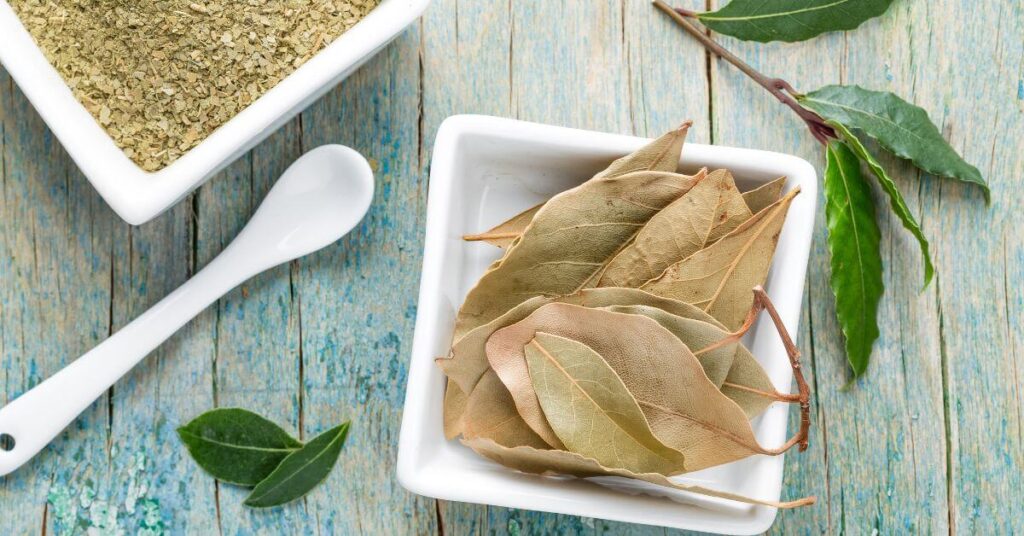
If you’re making soup, stew, or sauce, you need bay leaves. This flavorful addition can make all the difference in your dishes once you know how to cook with bay leaves!
On Sunday at mom’s house, you can always smell something delicious cooking. Sauces, stews, soups, and more, whatever mom is up to it, always smells and tastes delicious, and that is because of the bay leaves. Bay leaves are an incredible flavor enhancer that makes many dishes richer, but the trick is knowing how to use them. Grab your apron, and let’s get simmering with this delicious guide on how to cook with bay leaves!
What are Bay Leaves?
Bay leaves are used as culinary herbs or seasoning. This vibrant leafy ingredient has been livening up dishes for ages, and it comes from laurel trees. The leaves are thin, green, arrow-like points and are used both fresh and dried in dishes.
They are known for their strong aroma and flavor. The flavor is fresh, leafy, and similar to oregano thyme.
Why Cook with Bay Leaves?
Bay leaves are a powerful addition to long-stewing recipes. In one small leafy package, they can deliver tons of herbal flavor. They are a great way to add a lot of flavors, especially when you’re short on other ingredients.
When crushed and used in recipes, bay leaves can add nutritional value. They have lots of vitamins, including A, B6, and C. In addition to being vitamin-rich, they’re full of calcium, iron, and manganese. All this makes them not just delicious but a very nutritious addition to sauces, soups, and stews.
How to Store Bay Leaves
Dried or crushed bay leaves can be stored on your spice shelf or drawer. Keep them in an airtight container for up to 6 months. Spices stored longer than 6 months may lose flavor or lose quality.
How to Cook with Bay Leaves
Bay leaves might be the key to extracting the flavor you want out of your favorite recipes. Use these simple ideas to get started cooking with bay leaves.
Stews
Stew is the perfect dish to cook with bay leaves. The slow cooking time in this simmering dish allows the leaves to infuse flavors into the dish slowly. No matter the style of stew you’re making, this one ingredient can make the meal better!
Start by cooking the vegetables and meat until the veggies are slightly softened and the meat is brown on the exterior. Add the stewing liquids and seasonings. Drop a few bay leaves in and stew your dish as the recipe directs.
Before serving, fish the bay leaves out. They will leave plenty of leafy, herbal flavor to level up your stew!
Soups
One or two bay leaves can add flavor to any soup. This trick even works with store-bought or canned soup!
To enhance a soup with bay leaves, add a leaf or two to the pot of simmering soup. Allow it to cook for a few minutes, stirring often. Remove the bay leaf before serving. Get ready to be amazed at how much flavor the leaves can add with so little effort!
Braises
Braising is a technique where meat is cooked with a little liquid to help seal in the juicy tenderness of the meat. It’s a great way to keep the meat juicy and an opportunity to use some great bay leaf flavor.
To braise with bay leaves, add the bay leaf with the other vegetables. Allow the bay leaves to remain in the pot while the meat braises, and remove them before serving. This will add a rich, fragrant, almost piny flavor to your rich braised meat.
Pasta Sauce
Making pasta sauce is a delicious weekend activity and a great reason to cook with bay leaves! Whether making your own sauce from scratch or looking to dress up a jar of sauce, bay leaves are just what you’re looking for.
To enhance a jarred pasta sauce with bay leaves, pour it into a pot and heat it on the stovetop. Add a couple of bay leaves while it simmers. Fish the leaves out before using, and enjoy!
For homemade sauces, it’s a similar process; only the bay leaves can be added with the other herbs and spices to simmer in the sauce.
Beans
From baked beans to chili to beans and rice, there are lots of delicious bean dishes that would be even more flavorful with the addition of bay leaves!
Add bay leaves to canned beans when heating them up or fresh bean dishes while they stew. The bay leaves will infuse tons of earthy and leafy flavor into any bean dish you can imagine. Remember to remove the whole leaves before serving them for aesthetics.
F.A.Q.
Are Bay Leaves Poisonous?
There is a long-standing myth that eating bay leaves is poisonous, but it is just that, a myth! Eating bay leaves is perfectly safe, delicious, and 100% non-toxic for humans. The leaves are poisonous to dogs and cats, so do not share them with your pets.
Final Thoughts
Bay leaves can bring so much leafy and herbal flavor to dishes that knowing how to cook them is essential for any aspiring home chef. Taste how flavorful your sauces and stews become when using these awesome ideas on how to cook with bay leaves!
Additional Kitchen Resources
If you’re hungry for more delicious sauces, stews, and soups to use bay leaves in, try exploring these tasty kitchen resources.
- How to make Creamy Spinach and Italian Sausage Soup
- How to Make Jar Spaghetti Sauce Better
- What To Do with Leftover Sloppy Joe Meat
- How to Make Canned Enchilada Sauce Better
- How to Make Tomato Soup with Tomato Sauce



